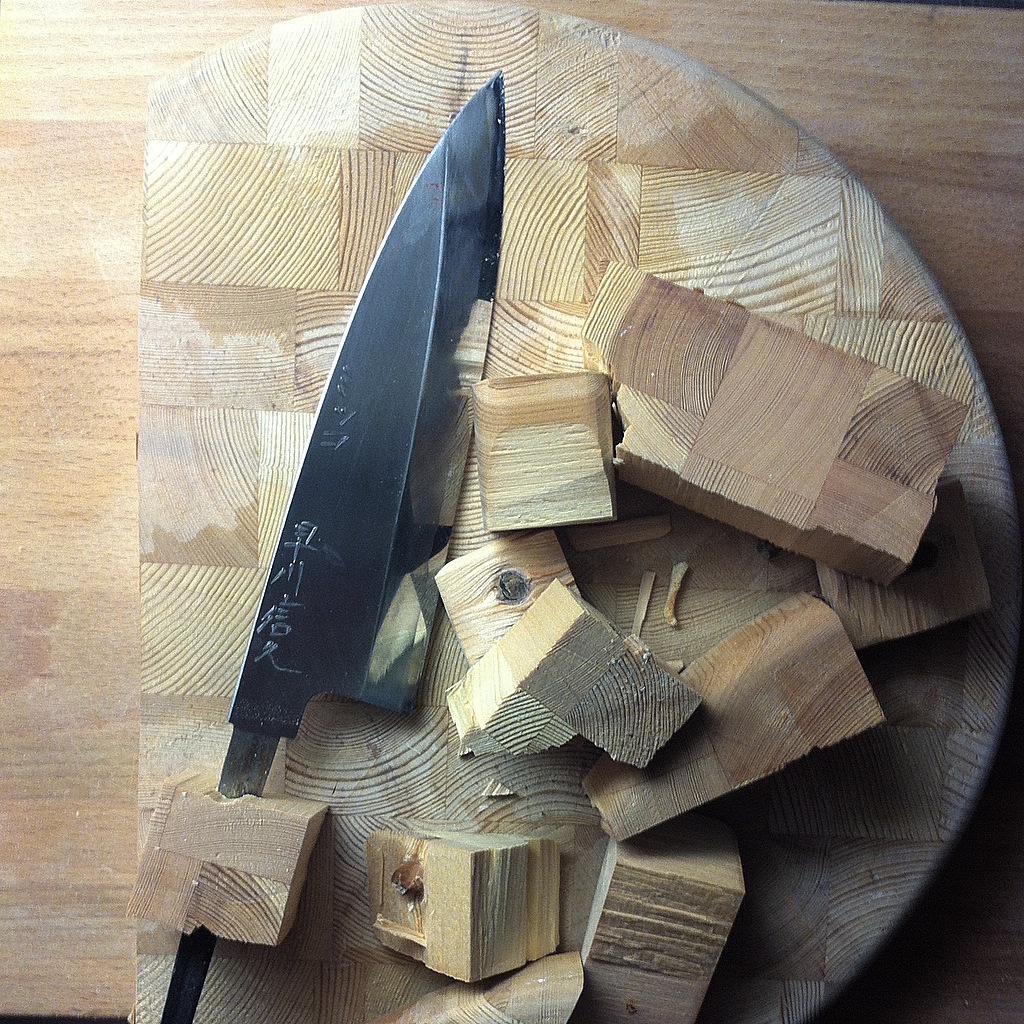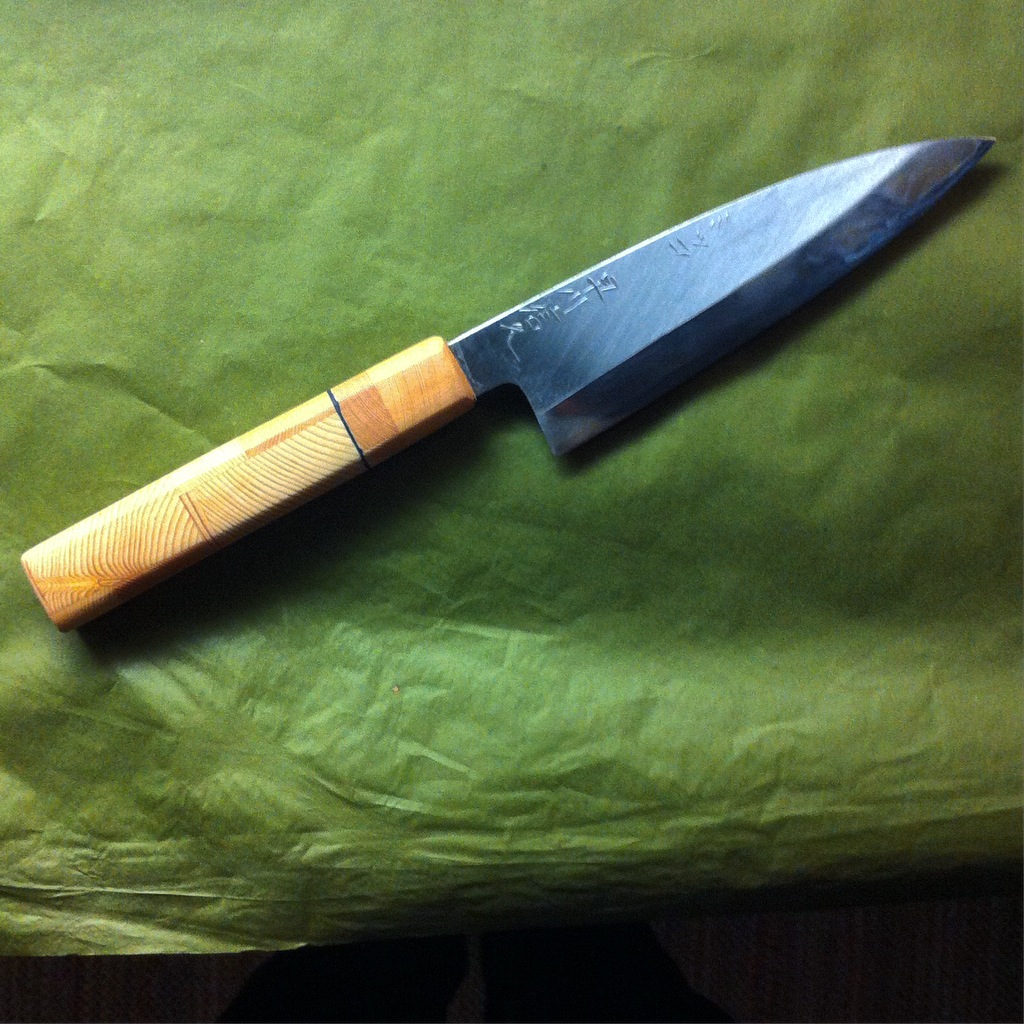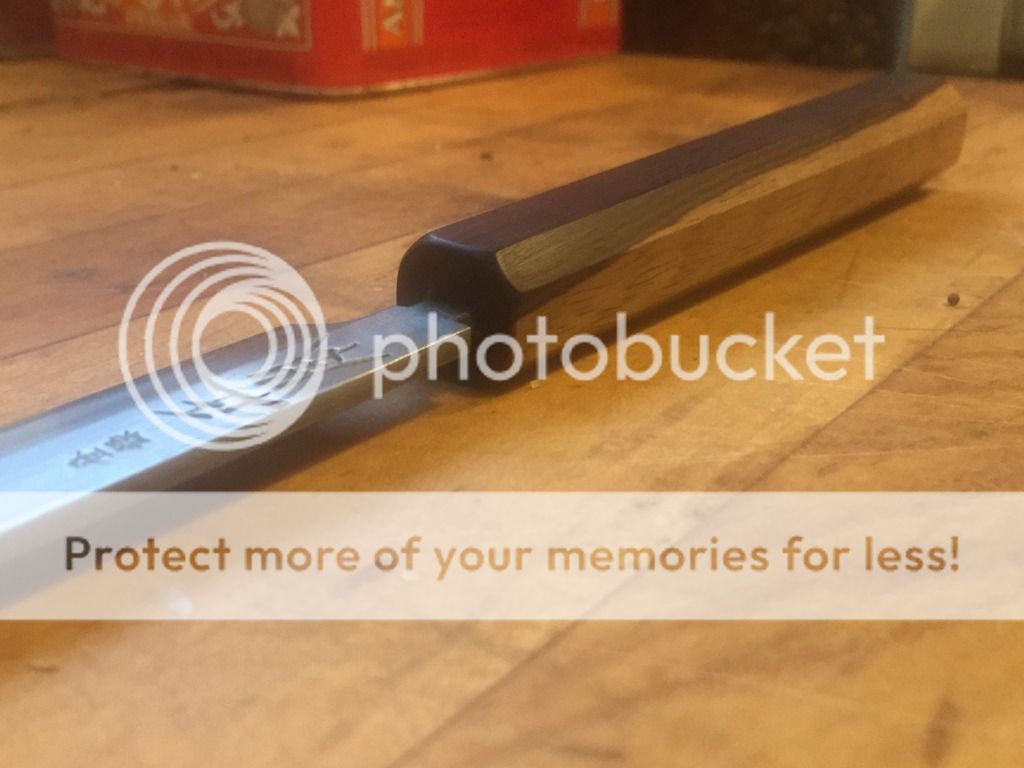You already got quite some advice, so here is how I make WA handles now (without metal bolsters). I have a 1x30" belt grinder with 5" disc grinder on the side.
1) Pick the material for the handle and the ferrule
2) If the handle blok is too large (they usually are for WA handles) - use the belt grinder with a coarse (say #40) belt to remove material from one or two sides. I usually get the block down to about 25 x 30 or a little bigger. Get the grind as flat as possible with the belt grinder.
3) use coarse (#80) sandpaper taped to dead flat hard surface (I have a piece of stone that was a small table-top) and flatten AND square-up the block - in particular the ends, then move to finer paper (say #180).
4) Do the same with the ferrule
5) If you plan to use a spacer (finer or thin wood) prepare it in about the same cross section as the handle block
6) Make sure all contact sides are dead flat.
7) If any of the wood materials are oili, rub the side where you plan to glue with ethanol and leave to dry for a while
8)I use G/flex epoxy (the less viscous one) as it has 45 minutes pot time, and glue the handle together and put in a long clamp (of some sorts)
9) Next day I take the glued block to a belt sander and clean it up - if necessary do some coarse stock removal (if the block was too large, etc.
10) Clean by hand on coarse and then finer sandpaper (I go up to about #240), square up the to of the ferrule.
11) Mark centrelines on all sides of the block with a pencil as well as on the top of the ferrule and on the other side of the handle.
12) I carefully 'tap' the butt of the handle where the center is, so that I have it as a reference point once I start to grind the handle closer to shape
13) I drill a hole to the block for a dowel - I use dowels with diameter of either 10 or 12 mm depending on the size of the handle. Here the drill press is indispensable - make sure you have the alignment right before you start to drill. Do not hurry during drilling.
14) I cut the pice of beech round stock - about 5mm longer than the depth of the drilled hole.
15) I cut the slot (as precisely as possible) with a hack saw, than use medium grit belt (usually #120) on the belt sander to adjust the width of the slot - keep checking it out against the tang of the blade for which the handle is intended. Make the slot some 5 mm longer than the tang.
16) Once the tang fits well I slightly sand the dowel from outside, so I am able to fit it inside the handle with the tang inserted - a dry fit, so to say. It should fit easily without needing much force - the fit will get tighter once you will start to glue it all together.
17) Apply small amount of epoxy (less is more here) on the outer sides of the dowel and put it inside the handle. I shortly insert the blade to make sure I get the right position (rotation) of the dowel.
18) I take the blade out, and us some narrow wedge (off-cut piece of steel that slowly gets wider along its length is perfect) and insert it inside the dowel - this way I can make sure that there will be no gaps between the dowel and the ferrule.
19) Allow the wood to cure until the next day.
20) Check the fit again - with good probability some glue leaked in the dowel and you may not be able to fit in the blade. I use needle flat rasps on which I ground one flat side flat, so they are thinner and I have more control where I remove material.
21) Once the tang fits again nicely grind the front side of the ferrule and clean it up.
22) Since the handle is at this stage all squared up I can move to the pre-shaping of the handle
23) I draw the lines on the upper and lower side of the handle (tapering towards the ferrule) that already represent close-to-final width of the handle
24) I grind the sides of the handle with a belt grinder and clean and flatten them up by hand on the sanding stone with #120 sandpaper
25) Now I repeat the process - draw the lines on freshly refinished left and right side of the handle and grind and then flatten the top and bottom of the handle - inclusive a taper.
26) At this stage I have a pre-shaped handle that should have close to the final width and height. I still use the centrelines on the ferrule and bottom of the handle to keep things centred.
27) Now comes the tricky part. I use the disc sander with a fresh #150 disc and start to grind the octagonal shape. I check regularly and do this in iterative manner. Remember - once you grind too much, there is no way back. I check regularly in my hand and with the blade inserted as the impression on what feels right depends strongly on the weight of the knife.
27-B) If I want to do some additional tapering on the ferule I do it now.
28) Once I am happy with the shape I clean up all 8 facets on the sanding stone and with #240 paper (if I used #150 disc). One should be careful here and check that the pressure is being applied evenly over the facet being sanded, as one could easily over-sand on one side (or on one edge). I usually turn the handle front-to-back after a few strokes. The main point here is to remove all the scratches from the disc sander, but not more.
29) I continue sanding the handle by hand - I use a small block of wood of about 20 x 50 x 100 mm, put a strip of strong double-sided Tesa tape on each of the long narrow sides, and attach a strip of sanding paper. I go through grits 400, 600, and 1000 - depending on the wood I may stop at 6000, or go up to 2000. If the wood is some softer wood, I do wet sanding steps in between (240 wet, 240 dry, 400 wet, 400, dry, then only dry), so I do not get too much expansion once the handle will be oiled for the first time. I also sand (round) front edges on the ferrule with every grit. I only sand the butt of the handle under one constant angle, but that is just a matter of taste.
30) If the handle is to be treated with some hardening oil (Tru-Oil or Tung Oil) I do that now. I only sand the handle with 0000 steel wool and only as little as needed as it tends to round the edges on the WA handle fast. I repeat this step 2-3 times.
31) If I do not want to apply Hardening oil (e.g. with ironwood), I apply a few coats of board butter and sand with steel wool.
32) The handle is now ready to be mounted (glued). I use G/Flex epoxy for that as it flows relatively easily (OK, it needs some help) inside the narrow tang opening.
Yes - that is probably unnecessarily too complicated, but at least you know why does it take me so long to finish a project

I plan several more steps in the middle if the handle should have metal spacer, but I have not tried that yet, so it would be too early to share it as an advice.







